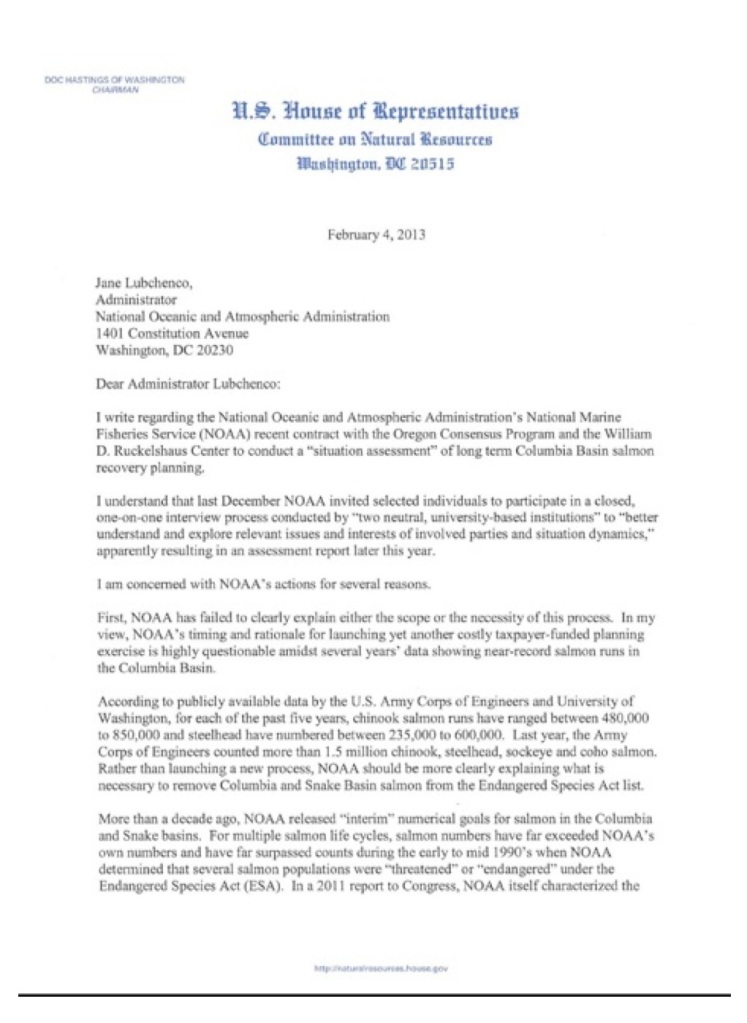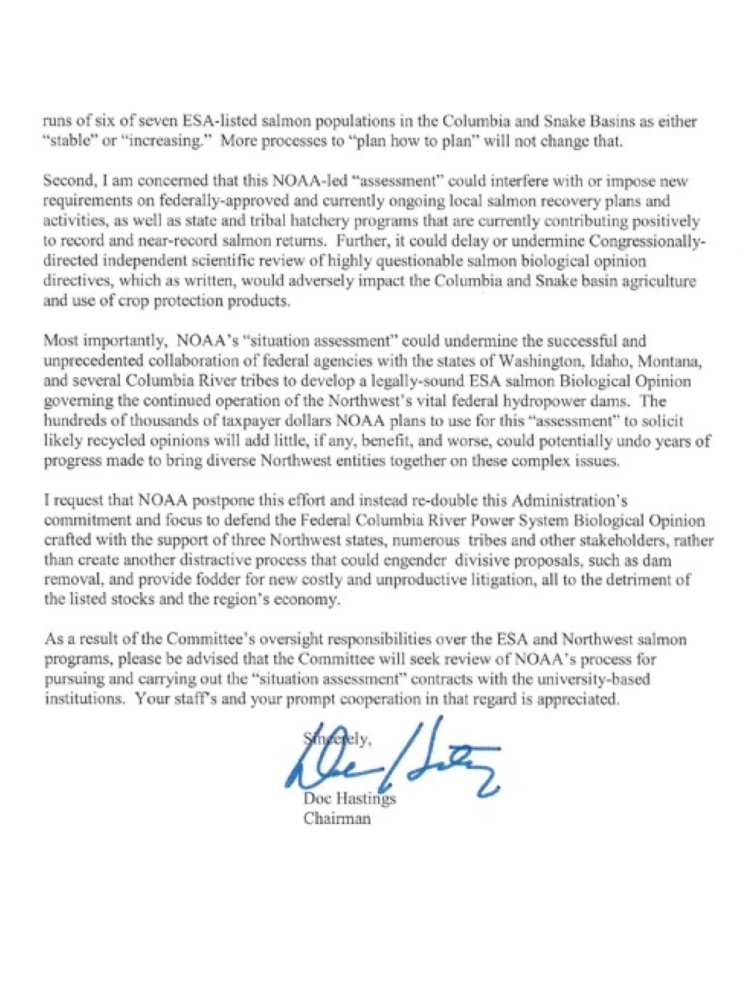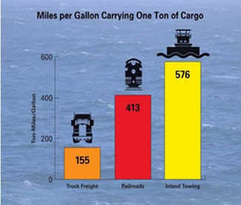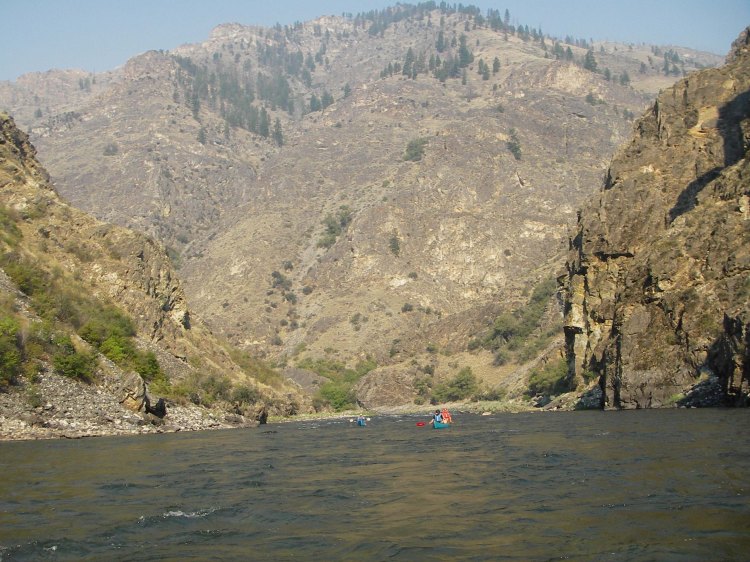Fish Story: Almost True tales of salmon Recovery from Rep. Doc Hastings
In a letter dated February 4th, 2013, U.S. Representative Richard “Doc” Hastings, Chair of the House Natural Resources Committee, wrote to outgoing National Oceanic and Atmospheric Administration (NOAA) Administrator Dr. Jane Lubchenco, to express his concern over a “situation assessment” undertaken by NOAA, which would begin with nothing more than an informal interview process, leading, if all goes well, to an informal dialogue among stakeholders, aimed at improving long-term Columbia Basin salmon recovery planning.
Hastings concerns, as written, contain several misleading or otherwise inaccurate statements.
As part of Larry’s ongoing mission to interest the public in the public interest on matters concerning rivers and fish, we offer a by-the-numbers critique of Rep. Hastings letter.


“NOAA’s timing and rationale for launching yet another costly tax-payer funded planning exercise…”
Talk is cheap. Not saving salmon has proven to be expensive. The estimated cost of NOAA’s situation assessment: $250,000, a pittance in NOAA’s $5 billion budget. Annual outlay for Endangered Species Act related actions at NOAA is $1 billion. Estimates of the annual cost of the ineffective federal plan to recover threatened and endangered ESA salmon on the Columbia vary from $300 million to a billion dollars a year.
At any rate, Hastings’ concern over frivolous use of taxpayer funds does not apply to all recipients of government largesse. In July 2011, Hastings voted in favor of a $147 million U.S. subsidy for Brazilian cotton growers.
“several years data showing near record salmon runs:”
Hastings statement simply doesn’t hold water: Number, according to NOAA, of 13 ESA listed species of salmon in the Columbia Basin recovered: 0. Forecasts for 2013 predict even fewer salmon returning than in recent years. Most stocks, including the 13 Endangered Species Act- listed runs, are expected to return at levels lower than the already dismal ten-year average.
The official forecast for this year’s wild spring/summer chinook, for example, suggest that just 11,000 adults will likely survive to reach Idaho waters after passing eight dams on the Columbia and lower Snake Rivers. Last year’s wild run was 21,000; 2011 was 22,000; and 2010 was 26,000. Increase in numbers needed for this species to have it removed from the Endangered Species Act list: a minimum of 80,000 wild chinook returning for eight consecutive years.
“NOAA should be more clearly explaining what is necessary to remove Columbia and Snake Basin salmon from the Endangered Species Act list.”
It’s not that NOAA hasn’t tried: In August of 2011, NOAA posted a status review of listed species of Snake River salmon, which stated in a summary of their scientists’ findings on spring/ summer chinook salmon, “the species is not viable.” Five days after this status review was posted, it was pulled from NOAA’s website without explanation. Currently there are no Columbia/Snake River status reviews of salmon populations available on the agency’s website. In August 2010, L.A. Times writer Tom Hamburger reported federal salmon scientists in the Pacific Northwest were pressured to mimimize the effects of dams on salmon.
“In a 2011 report to Congress, NOAA itself characterized runs of six of seven ESA-listed salmon populations as either ‘stable’ or ‘increasing.”
Thirteen, not six, Columbia/Snake River salmon populations are listed under the Endangered Species Act. Estimated annual number of salmon returning to the Columbia River Basin, prior to European contact: 10 to 50 million. A recovery target identified by regional planners in the early 1980’s would have increased salmon returns from what was back then a 2.5 million fish average yearly return to 5 million fish annually. Average since 2001: 1.4 million. Some salmon populations, as Hastings notes, are on the increase. But the bounce is due to a court-ordered release of water in the rivers in question. Hastings has introduced H.R. 6247, “Saving Our Dams and New Hydropower Development and Jobs Act of 2012.” A provision in the bill would give states the authority to override the federal court order to release water for salmon.
“… I am concerned that this NOAA-led assessment could interfere with or impose new requirements on federally-approved and currently ongoing local salmon recovery plans…”
“Federally approved” salmon recovery plans were declared illegal for the third time in a decade by federal district court in Portland, Oregon on August 2nd, 2011. Thus the plan is not federally approved.
“…state and tribal hatchery programs that are contributing positively to record and/or near record salmon returns.”
Hastings wrongly credits hatcheries for contributing positively to salmon recovery. At least 85 papers published since 1995 raise serious doubts about any purported benefit hatchery fish have on wild salmon. Fisheries biologists at Oregon State University and University of California at Santa Cruz have recently published studies showing hatchery-wild fish interbreeding which, when compared to wild breeding pairs, significantly reduces odds of their offspring’s survival.
“Further, it could delay or undermine Congressionally-directed independent scientific review…”
Hastings seems again to allude here to H.R. 6247, his “Save Our Dams” bill. The bill has not cleared the House, much less the Senate, where it has little to no chance of passing. In the meantime, Congress has directed no such scientific review.
“Crafted with the support of three Northwest states…”
Hastings here refers to the Columbia Basin Fish Accords, signed in April 2008, which will dole out nearly $l billion in future federal tax-and regional utility rate-payer money to states and tribes in exchange for these parties’ acquiescence to a federal salmon plan that was declared illegal in August 2011. The amounts paid: Shoshone-Bannock Tribes : $61 million. Confederated Tribes of the Yakima: $330 million. Colville Tribes: $200 million. Confederated Tribes of the Umatilla: $150 million. Confederated Tribes of the Warm Springs: $90 million. Idaho: $60 million. State of Washington: $45 million. Montana: $15.5 million. The Columbia Intertribal Fish Commission: $90 million. The money will be used for hatchery operations and habitat restoration work in tributaries of the Columbia and Snake, and in the estuary of the Columbia. In exchange for the funding, states and tribes promise to support and promote whatever federal agencies construe as salmon recovery. The agreement also takes Snake River dam removal off the table until at least 2018.
Beyond the problematic quelling of dissent, critics have pointed out that habitat and hatchery measures do not directly address the damage to salmon runs caused by federal dam projects in the mainstem Columbia and Snake Rivers.
“Fodder for new costly and unproductive litigation”
The Bonneville Power Administration, the agency in charge of marketing and selling power from the region’s dams, has already provided this fodder on at least two fronts. As has often been the case in the era of cheap hydropower in the Pacific Northwest, the region is sitting on an extravagant surplus of electricity. BPA’s method of dealing with this surplus, a policy known as “environmental redispatch,” gives priority to hydropower over the 5,000 megawatts of wind energy installed in the Columbia Basin over the past decade. The Federal Energy Regulatory Commission ruled in December of 2012 that disconnecting wind producers as currently practiced is illegal. BPA has also directed the region’s salmon recovery effort, which has also been declared illegal for the third time in a decade. BPA, along with NOAA and the U.S. Army Corps of Engineers, tout the program as the most expensive, and therefore most extensive endangered species recovery effort
in the world. But record costs aren’t a valid yardstick for success. The program has yet to recover any populations of salmon.
“…prompt cooperation is appreciated.”
Hastings was in a less cooperative mood himself back in 2010. Emboldened by his newly-appointed position as House Natural Resource Committee Chair, Hastings tried scuttle the removal of Condit Dam on the White Salmon River in his home state. The dam, now gone, was owned by Pacific Power.
Rep. Hastings, an avowedly pro-business, anti-regulatory conservative, was working from his powerful government position in order to interfere with the business decision of a private corporation, an irony that so far has gone under-appreciated.








